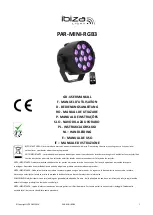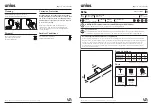
1.5.1
Binary Inputs – Timer
The Timer is specifically designed to measure high speed operation of electro-mechanical, solid-
state and microprocessor-based protection relays. In addition, it will perform timing tests on EHV
to low voltage breakers, trip circuits, and contactors. The factory default settings are:
Input 1: Timer start, normally open position, and latched ON
Input 2: Timer stop, normally open position, and latched ON
Input 3: Dry Contact monitor, normally open position, and latched OFF
And Inputs 4 through 16 as dry contact monitor, normally open position, and
latched OFF.
It incorporates the banana plug receptacles that may be programmed to be: Start Gates, Stop
Gates, and Monitor Gates, all Stop Gates, all Contact Continuity Monitors, or all Voltage
Applied/Removed Monitors.
1.5.1.1 Start, Stop, and Monitor Gates
In the TVI there are up to sixteen identical, independent, programmable gate circuits (Start, Stop,
and Monitor) that permit simple selection of the desired mode for timing or contact monitoring
operation. There are 10 internal inputs and 6 optional external inputs for the unit.
To monitor operation of the contacts or trip SCR in the device under test, an "ACTIVE" light is
provided for each gate. The gate circuit is isolated for voltage-sensing and can monitor solid-
state logic signals. Each “Active” light will illuminate once contacts close or voltage is applied to
the gate. If desired, a tone generator (horn) may provide an audible indication when the contacts
close or voltage is applied.
1.5.1.1.1 Dry
Contacts
Open
Timer starts, stops or a continuity indicator goes out at the opening of normally closed contacts,
or when conduction through a semiconductor device, such as a triac or a transistor, is interrupted.
1.5.1.1.2 Dry
Contacts
Close
Timer starts, stops or a continuity indicator glows at the closing of the normally open contacts, or
upon conduction through a semiconductor device such as a triac or a transistor.
1.5.1.1.3
Application or Removal of AC or DC voltage
This will either start the Timer or stop the Timer. The continuity indicator will glow (application) or
darkens (removal) upon the application or removal of either an AC or DC voltage. A higher
threshold voltage helps to eliminate false triggers due to a noisy source. Lower thresholds allow
starting and stopping of timer from TTL voltage signals. The allowable voltage applied is 5 to 300
Volts AC or 5 to 300 Volts DC, current limiting resistors provide protection.
1.5.1.1.4
The Timer can be started when turning on any selected generators.
1.5.1.1.5
The Timer can be started simultaneously with a change in Frequency, Phase
Angle, or Amplitude. Also, it can be started simultaneously with a Voltage or Current waveform
step.
1.5.1.1.6
The Timer can be stopped upon Phase Synchronization between two voltage
channels (normally used to time auto synchronizing relays).
19
www
. ElectricalPartManuals
. com
















































